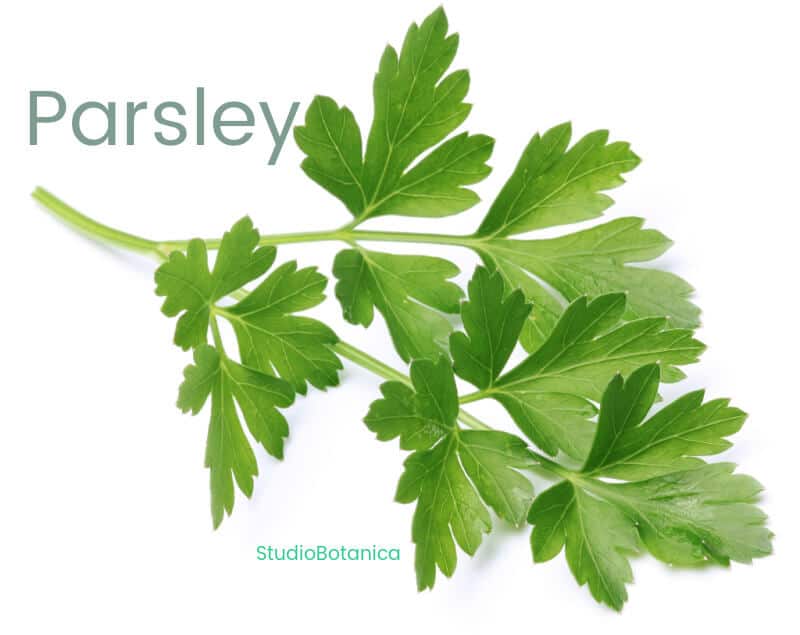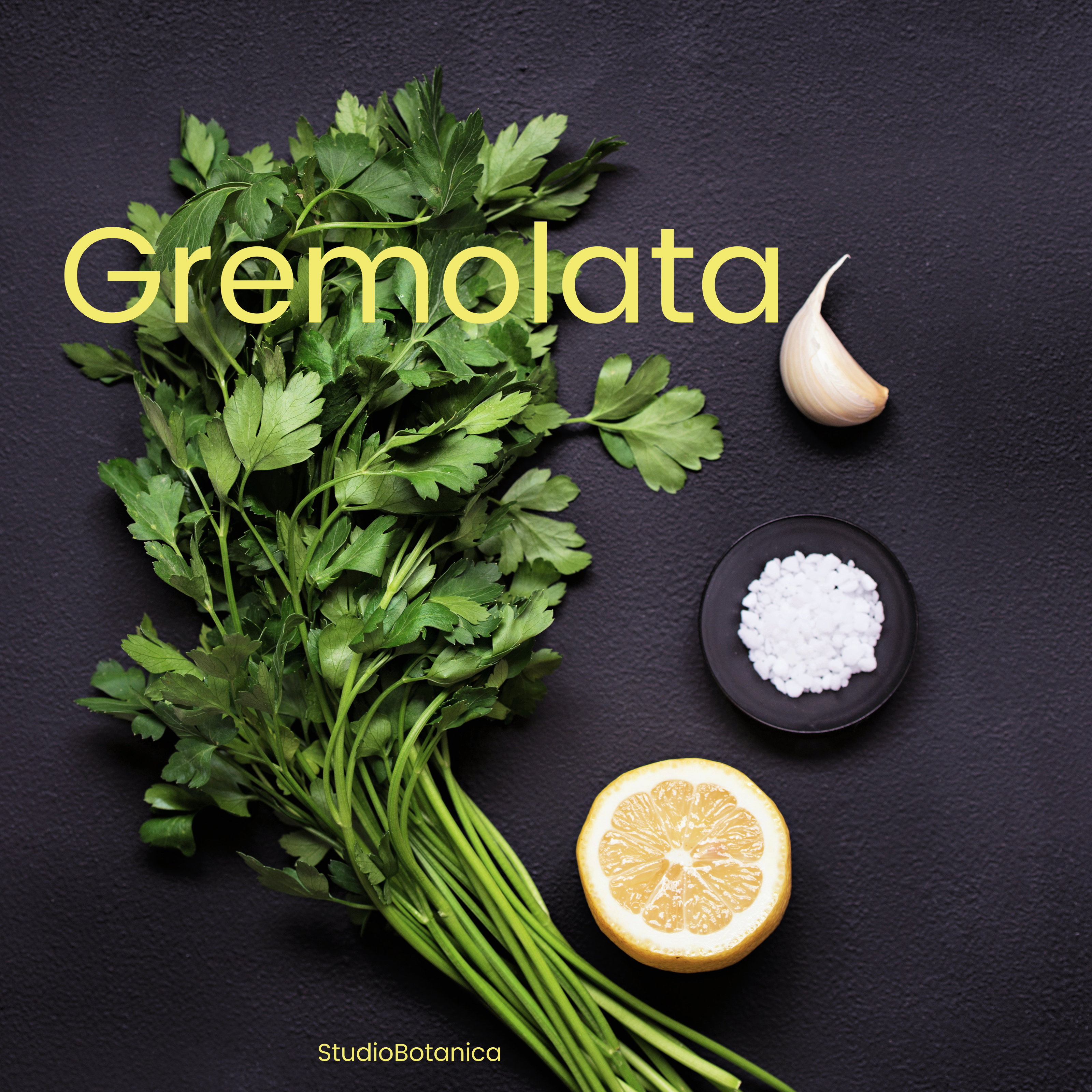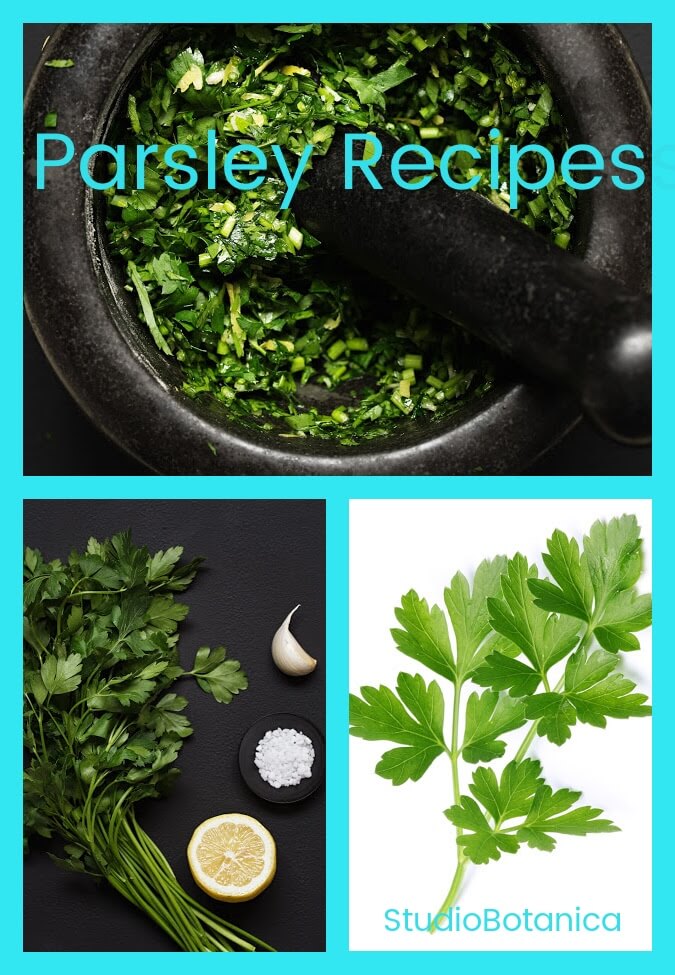Parsley Medicine ~ Often overlooked as a powerful plant ally, parsley is so much more than a garnish! Who doesn’t remember that toasted grilled cheese from the diner with that sprig of green parsley for decoration? In North America, this nutrient-dense herb has for years played the part of “greenery on a plate” to spruce up many a restaurant meal. There’s SO much more to this special plant. Read on for some yummy Parsley Recipes
Parsley (Petroselinum crispum) is a species of Petroselinum, a member of the family of Apiaceae plants. Other plants in this family include anise, carrots, celery, cumin, and dill. Both types, the “curly parsley” and also the “flat-leafed” or “Italian parsley” are common in gardens, garden centres, farmers markets and grocery stores.
Parsley is native to Mediterranean countries and indeed an integral part of many cuisines in the region. These cultures have grown and used parsley extensively for centuries in their meals and as traditional folk medicines, used as diuretics, anti-inflammatory aids, digestives, and detoxification remedies.
Parsley contains several important nutrients, such as vitamins A, C and K. It’s also an excellent source of folic acid plus the minerals calcium, iron, magnesium and potassium. (to name the major players)
In fact, 2 tablespoons (8 grams) of parsley provide:
- Calories: 2
- Vitamin A: 12% of the Reference Daily Intake (RDI)
- Vitamin C: 16% of the RDI
- Vitamin K: 154% of the RDI
Vitamin A is probably most famous as a support for our eyes but it is also a good support to our immune system. It’s renowned for skin health too and is often a part of skin condition treatments.
Vitamin C is vital to our immune system function, supportive of cardiovascular health and a powerful antioxidant, which can protect our cells from damage caused by the infamous ‘free radicals’ (unstable molecules)
Vitamin K is essential for optimum blood clotting, which can prevent excessive bleeding. This important nutrient also supports heart and bone health.
Parsley’s essential oil contains myristicin, limonene, eugenol and alpha-thujene. Research indicates that these compounds can benefit the body’s immune system, neutralizing oxidative stress and fighting off carcinogens. In fact, studies show that essential oils in parsley can actually slow tumour growth in cancer cases. (1)
Eugenol, in particular, has strong anti-inflammatory properties and is thought to help to alleviate the swelling and pain caused by arthritic conditions and other inflammatory issues.
Parsley Benefits
More formal studies are needed but a growing body of evidence suggests that parsley may offer multiple benefits, which may include helping with the following symptoms and imbalances (2):
- Acid reflux
- Anemia
- Arthritis
- Atherosclerosis
- Bad breath
- Bladder infection
- Bloating/edema
- Blood sugar
- Cancer (research indicates specific types of cancer helped)
- Constipation
- Digestive problems, including irritable bowel syndrome
- Gas
- Inflammation
- Kidney stones
- Oxidative stress/free radical damage
- Poor immunity
- Skin problems
After reading that lengthy list above, we can see how finding more ways to include parsley in our days is a great idea.
Herbalists may suggest a juice or a tea made from the leaves or roots or simply the practice of including MORE parsley in your meals. Everything is a habit! Eat more parsley! Read on for some of my all-time favourite ways to boost enjoyment of this super nutritious herbal ally.
Parsley tea/juice has been a traditional remedy for soothing the digestive system and decreasing tummy aches, supporting the kidneys and liver in detoxification processes. Parsley tea can help to soothe the throat. It is thought that asthmatic patients may benefit from this because parsley is a slight expectorant, so helps to ease coughs, release mucus and improve breathing. In fact, it can act as a sort of natural anti-histimine to relieve allergies, hay fever and other respiratory issues.
Parsley Recipes: How to make Parsley Tea:
2 to 4 tablespoons of fresh parsley
2 cups good quality water.
optional add-ons:
Ginger Root or
Fennel Seed
Place the parsley in a glass jar or teapot
Add just boiled water.
Place the lid on the jar or pot.
Allow to steep for 10 minutes
(or to your preference)
Ginger root and Parsley herb can help to soothe nausea in cases of stomach flu.
Fennel seeds and Parsley herb together can help increase movement in cases of stagnant digestion. This combination can also help to alleviate flatulence and bloating.
From a herbalists’ point of view
Herbalists tend to think of parsley with specific ideas in mind, as a medicinal herb. Here’s my take: I find that parsley as a carminative, is so helpful. It can truly help to improve poor digestion, issues of bloating, gas and constipation. We use carminatives, as well, to help people with a poor appetite, and those who need to ‘get the plumbing humming’ (to quote a dear friend). Even just a few sprigs of parsley eaten prior to consuming a meal, can help to improve assimilation.
Parsley is always thought of as a diuretic remedy and is well known for effects on the urinary system, especially in cases of cystitis (also known as urinary tract infection or UTI), edema, painful urination, and even kidney stones. Parsley roots are stronger than leaves and are sometimes made into a strong decoction in these cases.
Parsley can be used to stimulate uterine contractions to help to bring on a delayed menses or in specific cases of amenorrhea (lack of menstruation) I have used parsley as an emmenagogue in my herb practice to help in both these cases, with good results. Note: Although parsley is only a mild uterine stimulant, it’s best to avoid large doses during pregnancy. If pregnant, consuming parsley as a food is not an issue.
You may notice that in all three areas, above, there is a sense of “movement.” I noticed this years ago and began to use parsley in other areas as well, when the need for movement exists in the body. These are my observations only, but I have found that this is recorded in research as well–improvements in areas of the body where stagnation and other types of inflammation exist. Similar to dandelion leaf, parsley can help to dispel fluids from the body without depleting it of potassium.
Parsley contains both carotenoid antioxidants and vitamin C — both of which have been shown to benefit heart health. It seems that these components plus the specific essential oils in parsley, combine to support overall heart health and healthy arteries as well.
Parsley is known to be beneficial to blood circulation as a type of ‘vasodilator’ as it has been noted to help with the widening of blood vessels. It is thought to help to open up the blood passageways throughout the body.
Carotenoid-rich diets have been shown to improve heart disease risk factors like chronic inflammation, as well as elevated blood pressure and LDL (bad) cholesterol levels
I don’t know if there is a ‘therapeutic dose’, as we call it in herbalism, where a specific amount of an herb is needed before a change is noted. I do know that it’s a lot more than a parsley sprig as a garnish!
Parley Recipes are powerful Alkalizers:
Here are some ways to add parsley to your daily meals:
- Add to homemade bread, rolls or bagels
- Use on homemade pizza, alone or with other greens
- Use in quiches, scrambles or frittatas.
- Make a pesto parsley as the star or make up a green blend of basil + parsley or dandelion + parsley
- Include in vinaigrettes or a delicious marinade.
- Make home-made juice combinations or add to morning smoothies to create high nutrient dense drinks
- Add flavour to sauces, soups and stews
- Use as a ‘rub’ to add flavour to poultry, meat and fish dishes.
- Chop to make a salad, or add to salads
Diana De Luca, author, herbalist, teacher, and mentor, shared these ideas with me recently. I confess to being addicted to her quick parsley salad below. I hope you’ll try it! Diana is definitely one of my all-time favourite herbalists and one of the legendary “Garlic Queens.” I was always in the front row of any class she taught at the annual Women’s Herbal Conference.
Using food as medicine, Diana makes a yummy parsley salad to keep away and help treat urinary tract infections. She describes it as “Italian parsley drizzled with a little olive oil pinch of sea salt lemon juice and a thin drizzle of maple syrup smashed up with your hands and allowed to sit a few minutes.”
Quick Parsley Salad
1 bunch of parsley (flat leaf), chopped
2 tablespoons olive oil
1 pinch sea salt
2 tablespoons maple syrup
Lemon zest, optional
Garlic, minced, optional
Place all ingredients in a large bowl. Smash all together with your hands. Wash your hands (lol) and enjoy!
Diana’s Gremolata
Traditionally, gremolata would be used as an additional level of flavour to meat dishes like grilled lamb or beef. I’ve served it, with heavy meat dishes, on the side, or tossed with veggies and it’s a crowd-pleaser! I often make a big batch and freeze extra in small jars or even in ice cube trays.
Ingredients
- 1-2 cloves garlic minced
- 2 teaspoons lemon zest
- 3 tablespoons olive oil
- Pinch sea salt
- Pinch cayenne pepper optional
- 1 cup Italian parsley chopped
Instructions
-
Place the garlic, lemon zest, olive oil, salt and cayenne, if using, in a bowl with the chopped parsley.
-
Mix well with a wooden spoon.
-
Taste.
-
Adjust seasonings.
Recipe Notes
Optional change-ups or additions:
1 teaspoon rosemary, fresh, minced
1 teaspoon dried or fresh oregano, minced
or a handful of spearmint fresh leaves, finely chopped
or go wild with finely minced, freshly picked fir needles.
Store in glass jars in the fridge for 3-4 days.
It should keep for up to 2 weeks if there is a little film of olive oil over the top, covering the ingredients.
It will also freeze well. Label and it’s ready to enjoy all year ‘round.
To make a larger batch, just double or triple the ingredients and use a food processor to whip up in a flash!
Sometimes, I make a kind of 'processed' gremolata -- as a kind of versatile 'herby sauce'.
Use the details above but place the parsley, lemon zest and garlic in a food processor.
Add the olive oil + seasonings + give it a whirl!
I slather it on veggies, or toss it with warm pasta or potatoes!
Parsley Recipes are worth checking out -- SO much more than a garnish! So worth exploring and making a big part of your week!
Here's to our health -- one spoonful at a time.
xo Carol
Are you a Pinterest fan? Come for a visit and see lots of herb-infused goodies on Studio Botanica's board!





Norma Steiner
I always ate parsley because I liked it. I didn't realize how good it was for me!! Great information and recipes
Carol Little
I think that is one of the reasons that our plant world is so very magical.. Parsley is just another example of incredible healing powers in a plant that is so often over-looked..